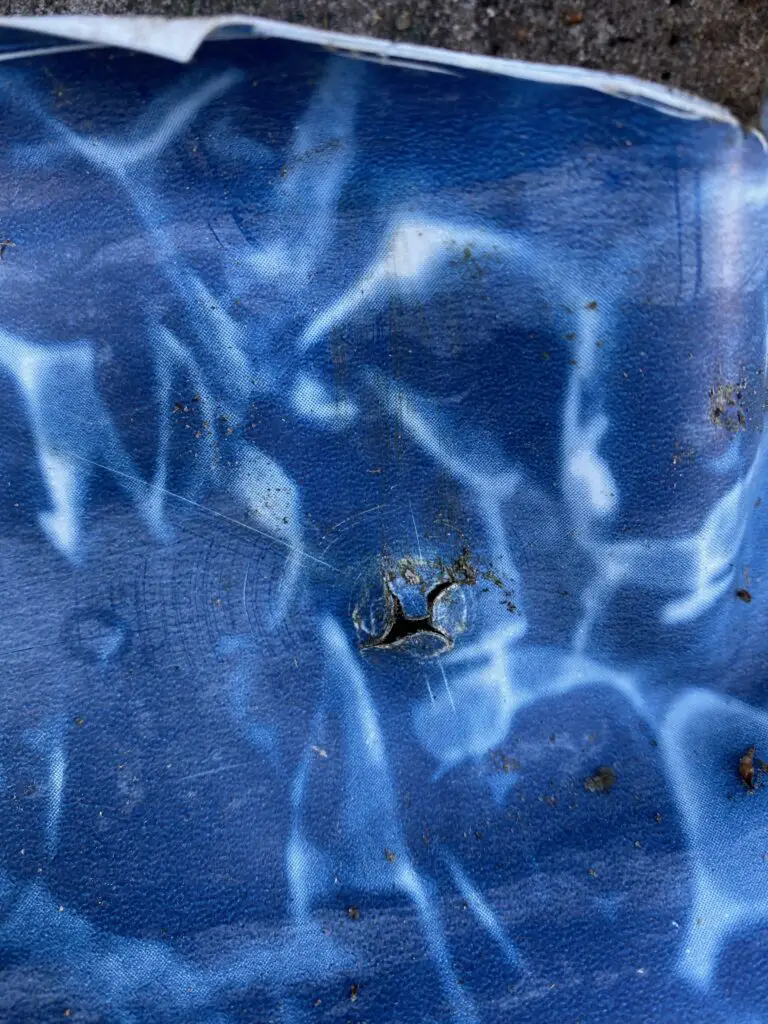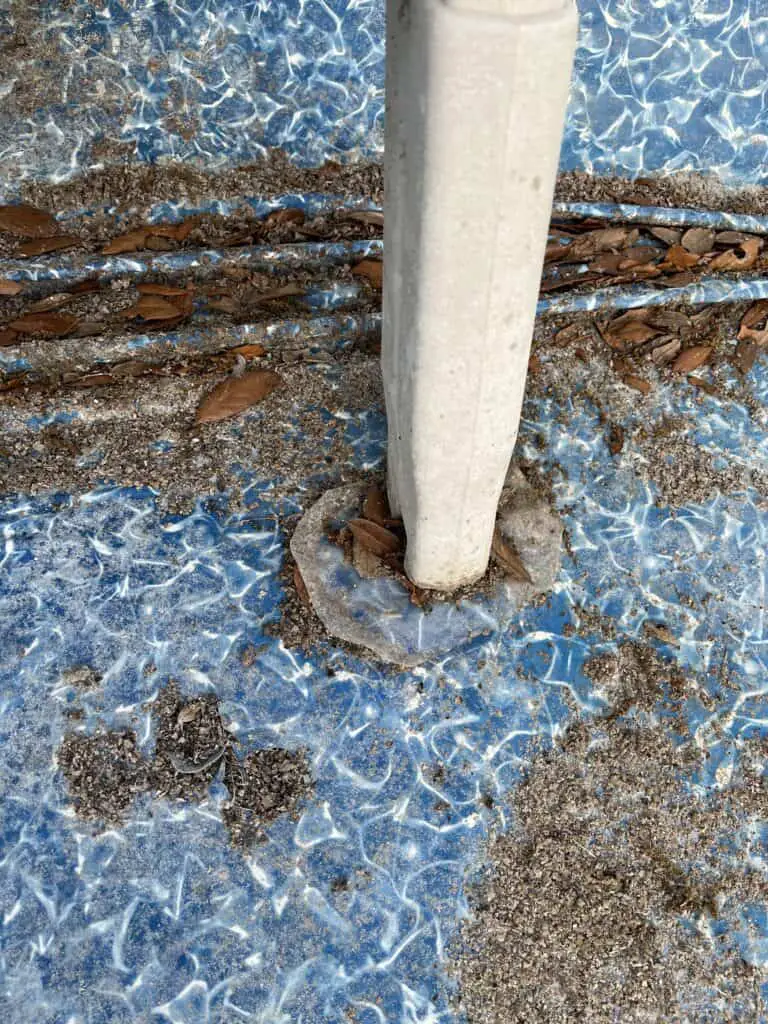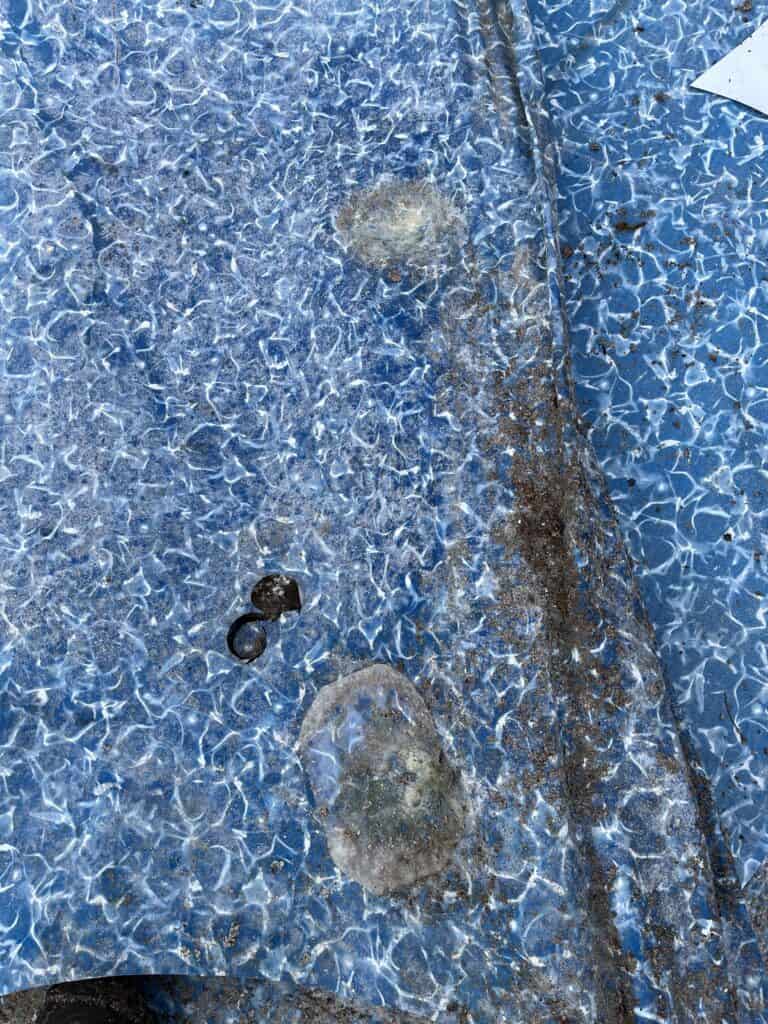It’s never fun when your swimming pool is leaking. With vinyl-lined above-ground pools, most leaks happen around the skimmer or return fitting. The positive here is that the leak is often visible, so you know where it needs to be fixed.
Leaks in or around the skimmer or return fitting are always the result of either improper installation and/or faulty gasket.
Other leaks in above ground pools happen somewhere within the pump and filter which is good too as you can see where it’s leaking and fix it.
What about leaks in the body of the pool? Yeah, they are the worse because they can be impossible to find. If you can find a leak in the liner somewhere, it’s usually an easy patch job, so that’s good.
HAVE A HOLE IN YOUR ABOVE GROUND POOL LINER? TIME TO PLAY THE BLAME GAME
It’s perfectly natural for pool owners to get irritated when they find out that they have a hole somewhere in their liner. The immediate reaction for some is “Whose to blame for this?”
As a pool installer, I have been blamed for many holes in liners. Some were, in fact, my fault but most weren’t. The product gets blamed a lot too, although it’s rarely the product’s fault either.
Kids get blamed for holes in pool liners often too. And to be honest, a lot of times they are correct with that one.
Other things people blame holes on are direct sunlight and poor pool chemistry, which is also very rarely the cause.
In reality though, something has to be responsible for a hole in a liner. The following list may help you be more accurate when playing the blame game.
13 THINGS THAT CAN CAUSE A HOLE IN AN ABOVE GROUND POOL
1 Seam separation
Although rare, seam separations are manufacturer defects that happen in one out of every two hundred liners that I install.
You will know it’s a seam separation when the hole in the liner is directly on a seam. And it won’t stay small. It’ll continue to separate, so patching it will only buy you some time.
Learn more about seam separations here
2 Old/brittle liner
When a liner gets older, the material starts to break down and it gets brittle. And brittle liners get holes in them very easily.
Some cheaper liners (standard gauge, solid blue, and/or made in China) will get brittle in just a couple of years. Most good quality liners won’t start getting brittle for at least four years or longer.
If your liner is more than four years old and you’ve gotten a hole in it, patched it, then a month later, got another hole somewhere else, then it may be brittle.
Brittle liners will only get worse, so if the liner is older and you are getting holes, replace it.
3 Swimming dogs
Lord knows we love our dogs! Letting them swim freely in an above-ground pool though can result in some leaks high up.
Dogs have only one technique for treading water. Yep, it’s called the “doggie paddle”. Allowing a dog to doggie paddle too close to the pool’s wall can cause small tears in the liner where its paws hit the vinyl.
I am surprised at how often people don’t know that a hole/s in their liner at the waterline was from their swimming dog. I hear things like “but he never touches the pool wall” or “he hardly ever goes in the pool” or “but his paws are trimmed” and more.
Tears from dog paws can be hard to see at first, but once you see them and can take a close look, the small tears in the liner and where they are located make it very obvious as to how they happened.
The good news here is that most can teach their dogs not to doggie paddle against the wall of the pool. Dogs are smart and it takes a little training, but it’s very common for them to grasp that you don’t want them putting their paws against the wall.
Some can’t seem to teach their dog anything. To that, I have two words – Ceaser Milan.

4 Kids using things not meant to be in the pool
I’m in no way a militant rules type guy, but in the case of above-ground swimming pools, it’s a good idea to make a rule to not allow kids to bring anything in the pool that’s not made to be in a swimming pool.
Things that are sharp or made of metal are never good things to have in a vinyl-lined swimming pool. It’s fun for kids in pools. And I get allowing them to do what they want because they are kids.
Get a hole or two in the liner because your or someone else’s kid brought some non-pool item in the pool, and your liberal stance on allowing kids to play freely might stiffen a little.
And just so you know, kids playing in the pool with things that make holes is a very common way that pools get holes in them.
5 Horned-nose beetles
Beetles can crawl under pool liners. The ones with horns can make holes in the liner.
Not all areas have horned-nose beetles, so this may not be something for you to worry about. Learn more about horned-nose beetles and above-ground pools here.
6 Nutgrass
There is only one type of grass that will grow through a liner. And that is a grass called nutgrass or nutsedge.
Nutgrass can be a real problem if you have a lot of it in your yard. And don’t think that putting down a liner pad or weed block or foam boards prior to the liner will stop it. They won’t.
If you look down into your pool and can’t believe your eyes because it looks like a perfect blade of grass is growing at the bottom. Believe it. It’s nutgrass.
Learn more about nutgrass here.
7 Automatic pool cleaners
This is rare, but does happen. Automatic pool cleaners made for above-ground pools are designed to not cause any damage to the liner as it moves around. But sometimes it will cause a hole or tear if the conditions are right.
The conditions being “right” usually includes a very bumpy bottom along with something wrapping around the cleaner in some way to cause a “perfect storm” scenario that punctures or snags the liner.
8 Brushing the pool
This is a very common way that an older liner gets a hole in it. The older liner is getting brittle anyway, so the nylon bristles of the brush puncture it.
Some will mistakenly use a pool brush designed for concrete pools to brush an above-ground pool. This will cause holes as the bristles are more rigid or some are made of stainless steel. Not good.
Over the years, I’ve had more than a few pool service companies pay me to replace a liner in an above-ground they were servicing for this reason. They mistakenly used a concrete pool brush on it resulting in putting holes in the liner.
Many pool companies will decide at that point to stop servicing above-ground pools altogether.
Be very careful when brushing a vinyl pool. And only use a brush made for vinyl.
9 Sharp objects left in the earth
Most things accidentally left in the ground will be felt, but won’t cause a hole. Some will though.
Usually, something sharp left in the earth and under the liner will give some, and/or the liner will wrap around it and not make a hole. Some things in the ground that won’t give and is sharp will make a hole.
This is usually felt by someone’s foot before any water loss is noticed. When that happens, the sharp object usually can be tapped down flat and an underwater patch placed over the hole. After that, it will never leak again and you will never feel the object again.
10 Washed out coving
Metal-walled above-ground pools need to have a coving or build-up of earth to transition between the bottom of the wall and the bottom of the pool.
This coving is usually made from earth or sand and can get washed away in some areas if there is a leak somewhere on or close to the wall of the pool. If the coving washes away, it can expose the bottom track of the pool to the liner. And the bottom track may have some sharp edges that cause a hole in the liner if exposed.
There is a thing called “foam coving” which is used as the cove instead of earth or sand. Foam coving cannot wash away, so that’s an advantage to getting it.
11 Sharp things falling in the pool
Anything around the pool that is sharp or has a piercing ability can fall in the pool and cause a hole in the liner. It’s rare of course, but happens all the time to people.
Overhead tree branches are the cause of many of these. It doesn’t have to be big. It just has to be big enough to fall in the water and spear its way to the liner.
Other things like cover supports, umbrella center posts, and decorations like pool signs can blow into the pool and cause a hole in the liner. Sometimes things freakishly fall in and make holes with million to one odds.
12 A root left in the earth
Roots are common reasons for holes in the bottom of an above-ground pool. The reason is that the root is still attached to the root system in the ground and therefore cannot be tapped down.
This is a big concern for me when I am installing a pool in an area with a lot of roots. Roots that have been severed and are left in the earth are not a big deal because they are no longer attached and can move downward and flatten with some give.
A root that is still attached is a different story. It cannot be tapped down and will stay poking up while the pool fills with water and poke a hole in the liner.
If a root is big enough and still attached, sometimes the only way to fix it is to drain the pool, peel back the liner, and cut the root out. This is a major pain.
13 Rusty wall
Walls of an above-ground pool can start to corrode and get quite rusty in spots. When this happens, the rusty spot of the wall can get sharp and cut a hole in the liner resting against it.
This is one reason why it’s a good idea to install wall foam to an older pool with a rusty wall when replacing the liner. The new replacement liner could get damaged by resting next to the rust. A thin layer of foam is glued to the wall to act as a soft barrier between the new liner and the rusty wall.
Learn about wall foam and above-ground pools here.
FOUR THINGS THAT WILL TYPICALLY NOT CAUSE HOLES IN ABOVE GROUND POOL LINERS
There are four common things that people commonly blame on holes for their above-ground pool, but don’t usually cause one.
1 Moles – Moles will commonly crawl under above-ground pools. And although they cause some damage to the bottom with their trails causing permanent ruts, they rarely make holes in the liner just above.
Mole damage often gets accused of causing leaks, but I very rarely see any holes in liners associated with the trails moles make. The vinyl is very forgiving and will simply just stretch to conform to the ruts.



2 Ladders/steps – It is very common for pool owners to be concerned with the inside portion of their ladder or steps causing holes in the liner where it lies.
In the 37 years of me working on above grounds though, I have maybe seen apparent liner damage from steps/ladders maybe twice. It’s just not at all common.
If you are concerned with this, they do make a ladder pad that goes between the bottom of the steps/ladder and the liner of the pool. This is a lot like a shower pad and will protect the liner from the contact points of the steps.
3 Rocks or roots – It doesn’t matter what it is left in the earth, if a pool owner feels it and it feels protruding or sharp, they will assume that it will make a hole in the liner.
In reality, rocks, roots(no longer connected SEE ABOVE), and even pieces of glass left in the earth will rarely make a hole in the liner. The Reason – Because the vinyl liner is very pliable and will wrap around things instead of tearing.
Think of trying to poke a needle through a rubber band. The rubber band just stretches around the head of the needle instead of quickly poking through.
Most things left under a liner can be easily pushed downward into the earth so you don’t feel it anymore. Other things that are more persistent can be gently tapped down using a small piece of wood and a hammer. This can be done with the pool still full of water. Usually, no hole will be made when tapping it down flat.

Ok I was moving my pool vacuum around to hit some spots that it missed and I put the metal pool net pole into its ring to move it. I accidentally hit the bottom of the pool with the pole and moved it. Do you think that might cause a hole?
Usually not but if the liner is older and has possibly gotten brittle, then yes.
I have an intex 15 x 15 above geound pool. I have had one hole after another inside of pool near the seam. I fixed one hole only to have another hole pop up within a few hours. I’m at my witts end with #5 hole patches just today and going to bed I hear the pump working hard and sure enough right next to the last hole I fixed there’s another one! Does intex replace lining if it’s a seam issue ans ive had it just one year.
I’m wondering how old your Intex pool is. Most only last a season or two. This reads like your pool is old and needs to be replaced.
Hi,
I am replacing a liner on my above ground every 2/3 years, pinholes show up almost on a straight line and every time is at different water levels, this year I patch it all around the water level with underwater tape so I hope it will hold the summer.
I am going out of my mind about this, no dogs, metal tools in the water, this pinholes just show up at any moment dropping the water line to where they are.
I lined the ground the pool with a 3mil plastic layer buy iy still did it after 2 years.
PLEASE ADVISE!!!
I have never seen or heard of pinholes in a straight line on the side of a liner. Because they are on the side and fairly high up, I guess I would rule out anything alive or organic causing this from the inside OR outside of the liner. And since a liner doesn’t move at all away, up/down, or sideways against the wall, I would rule out them being caused from the outside of the liner (the liner side touching the wall).
My guess then is the pinholes are being made from the water side of the liner. That’s all I have.
Also, when you change the liner next, remove that plastic. It’s not protecting anything but can cause moisture to get trapped and rust out the wall from the inside.